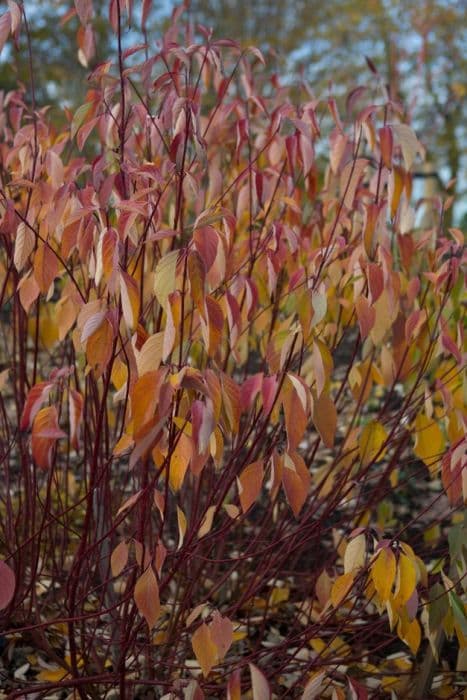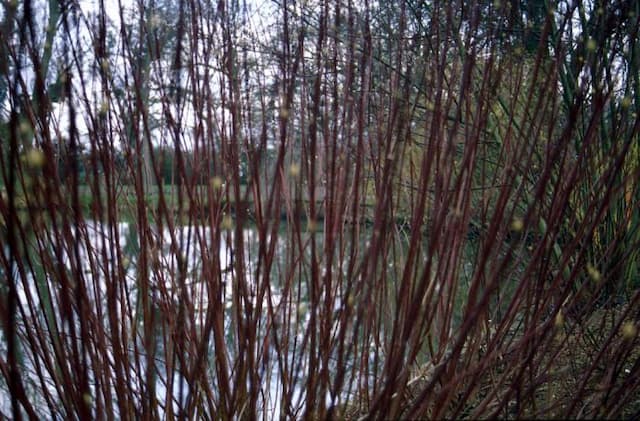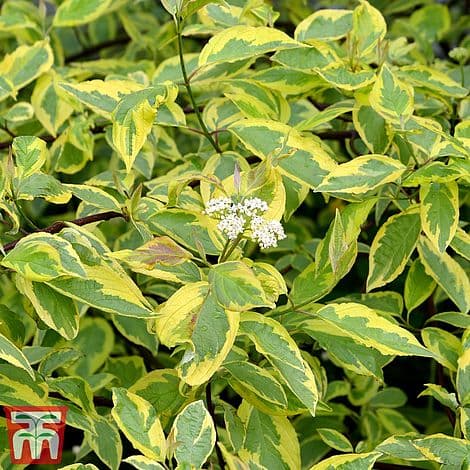Wedding Cake Tree Cornus controversa 'Variegata' (v)











ABOUT
The plant known as Cornus controversa 'Variegata' (v), or more commonly referred to as the wedding cake tree, is a striking deciduous shrub or small tree known for its distinctive horizontal branching pattern, which gives it a tiered appearance reminiscent of a wedding cake. The foliage of this plant is particularly attractive, featuring leaves with creamy-white margins surrounding a green center. The variegated leaves are oval in shape and come to a point at the end. In the spring, the wedding cake tree produces clusters of small, star-shaped flowers that are creamy-white in color, adding to the plant's ornamental value. These flowers are followed by dark blue-black berries which can attract birds and wildlife. During the fall, the variegated leaves turn a mix of bright reds and purples before shedding, providing a brilliant display of autumn color. The contrasting colors of the leaves and the distinctive, layered branching make the wedding cake tree a standout in any landscape where it is used for its ornamental qualities.
About this plant
 Names
NamesFamily
Cornaceae
Synonyms
Variegated Table Dogwood, Wedding Cake Tree
Common names
Cornus alternifolia f. controversa, Swida controversa, Chamaepericlymenum controversum.
 Toxicity
ToxicityTo humans
The plant commonly known as the Wedding Cake Tree (Cornus controversa 'Variegata') is not considered highly toxic to humans. However, ingesting parts of this plant, particularly in large amounts, may cause mild stomach upset. Symptoms could include nausea, vomiting, or diarrhea. It is always advisable to err on the side of caution and avoid eating parts of ornamental plants.
To pets
The Wedding Cake Tree (Cornus controversa 'Variegata') is not typically known to be highly toxic to pets either. Nevertheless, consumption, especially if in large quantities, could potentially lead to gastrointestinal upset in some animals. Symptoms such as vomiting or diarrhea may occur if a pet ingests part of this plant. It is recommended to keep an eye on your pet and consult with a veterinarian if any unusual symptoms appear after ingestion.
 Characteristics
CharacteristicsLife cycle
Perennials
Foliage type
Deciduous
Color of leaves
Variegated
Flower color
White
Height
15-25 feet (4.5-7.6 meters)
Spread
15-20 feet (4.5-6 meters)
Plant type
Tree
Hardiness zones
5-7
Native area
East Asia
Benefits
 General Benefits
General Benefits- Aesthetic Appeal: Adds visual interest to gardens with its variegated leaves and distinctive horizontal branching.
- Seasonal Interest: Offers year-round beauty with white flowers in spring, variegated foliage in summer, and berries and foliage color in autumn.
- Wildlife Attraction: Provides nectar for pollinators and berries for birds.
- Shade Tolerance: Thrives in a range of light conditions, including partial shade.
- Low Maintenance: Once established, requires minimal care beyond occasional pruning and mulching.
- Canopy Layering: Contributes to garden structure by creating a layered canopy effect with its tiered branches.
- Drought Tolerance: Withstands periods of drought once fully established, reducing the need for frequent watering.
 Medical Properties
Medical PropertiesThis plant is not used for medical purposes.
 Air-purifying Qualities
Air-purifying QualitiesThis plant is not specifically known for air purifying qualities.
 Other Uses
Other Uses- Wedding decor: The Giant Dogwood's variegated leaves and tiered branches create a whimsical backdrop for outdoor ceremonies.
- Photography prop: Photographers might use the striking pattern of the Giant Dogwood in portraits or macro photography for a unique texture.
- Fauna attraction: The tree can be used in garden designs aimed at attracting birds and beneficial insects.
- Live painting subjects: Artists may use the intricate patterns and contrasting colors of the Giant Dogwood leaves as subjects for painting or drawing.
- Seasonal celebrations: Branches may be cut and used as part of harvest festival decorations due to their autumn coloration.
- Culinary decoration: Edible dishes or arrangements can be enhanced by including the non-toxic leaves as garnish.
- Educational tool: Schools and botanical gardens may use the Giant Dogwood to teach about variegation and plant adaptation.
- Garden sculptures: The tree's distinctive form can be trained or pruned into living sculptures in ornamental gardens.
- Shade provider: Planted in sunny gardens, the tree can offer dappled shade for understory plants that require indirect sunlight.
- Privacy screening: When planted in rows, Giant Dogwood trees can create a natural privacy screen with their dense foliage.
Interesting Facts
 Feng Shui
Feng ShuiThe plant Wedding Cake Tree is not used in Feng Shui practice.
 Zodiac Sign Compitability
Zodiac Sign CompitabilityThe plant Wedding Cake Tree is not used in astrology practice.
 Plant Symbolism
Plant Symbolism- Balance and Harmony: The tiered branching pattern of the Wedding Cake Tree symbolizes a natural balance and the harmonious growth, often making it a symbol for equilibrium in life.
- Diversity and Uniqueness: The variegated foliage of the Wedding Cake Tree, with its splashes of cream against green, represents diversity and uniqueness, celebrating individuality.
- Growth and Ascent: As the tree reaches upwards with its horizontal branches, it embodies growth and the striving for higher planes, both physically and spiritually.
- Strength in Adversity: The robust nature of the Wedding Cake Tree, being adaptable to various conditions, signifies endurance and the ability to withstand challenges.
- Peace and Calm: Its elegant structure and foliage bring about a sense of tranquility, often associated with a peaceful presence that soothes the soul.
 Water
WaterThe Wedding Cake Tree prefers to be watered deeply but infrequently, allowing the soil to become moderately dry between waterings. In general, watering once a week with approximately 1 to 1.5 gallons of water will suffice. However, during particularly hot or dry weather, you may need to water it twice a week. Always check the top few inches of soil for moisture before watering. Over-watering or allowing the tree to sit in waterlogged soil can lead to root rot, so ensure good drainage is in place.
 Light
LightThe Wedding Cake Tree thrives in a spot with partial sun to light shade. It should receive around 4 to 6 hours of sunlight per day, ideally in the morning with some afternoon shade to protect its variegated leaves from harsh sun that could cause scorching. A location that avoids the intense midday sun is ideal for this plant.
 Temperature
TemperatureThe Wedding Cake Tree is hardy and can tolerate a wide range of temperatures. It does best in temperatures between 60°F and 75°F, which are ideal for growth and health. However, it can survive in temperatures as low as -20°F, making it suitable for many temperate climates. It's less tolerant of extreme heat, particularly in combination with drought conditions, so protection from the hottest parts of the day is beneficial.
 Pruning
PruningThe Wedding Cake Tree requires pruning to maintain its shape, remove any dead or diseased wood, and to encourage the growth of its characteristic tiered branches. Pruning is best done in late winter or early spring before new growth starts. Light thinning helps to preserve the horizontal layers of the plant's structure. It is not typically necessary to prune this tree every year; every two to three years is often sufficient unless shaping is needed or damaged branches are present.
 Cleaning
CleaningAs needed
 Soil
SoilThe Wedding Cake Tree prefers moist, well-drained soil with a pH of 5.5 to 6.5. A balanced mix of loam, sand, and compost will best suit its growth.
 Repotting
RepottingThe Wedding Cake Tree does not typically get repotted as it is a large shrub or small tree meant for outdoor planting.
 Humidity & Misting
Humidity & MistingThe Wedding Cake Tree thrives in average outdoor humidity levels; too high or too low humidity is usually not a concern for this plant.
 Suitable locations
Suitable locationsIndoor
Not suited for indoor growth; it's a large outdoor tree.
Outdoor
Plant in well-drained soil; partial to full sun; water regularly.
Hardiness zone
5-8 USDA
 Life cycle
Life cycleThe life of Cornus controversa 'Variegata', also known as the Variegated Table Dogwood, begins with germination, where a seed grows in well-draining soil with sufficient moisture. Following germination, it enters the seedling stage, where it develops its characteristic variegated leaves that require partial to full sun to maintain their color. As it matures into the vegetative stage, the dogwood grows both in height and width, forming a horizontal, tiered branching pattern. During the flowering stage, usually in late spring to early summer, the plant produces clusters of small, creamy-white flowers, which can be followed by the development of dark blue-purple berries if pollinated. The fruiting stage not only provides ornamental interest but also attracts birds and wildlife. Finally, the Variegated Table Dogwood reaches maturity and continues to cycle through flowering and fruiting stages annually, while potentially living several decades with proper care and in the right environmental conditions.
 Propogation
PropogationPropogation time
Late winter to early spring
Propogation: The Cornus controversa 'Variegata', commonly known as the Variegated Giant Dogwood, can be propagated using softwood cuttings during the early summer when the new growth is just beginning to harden off. To propagate from cuttings, one should select healthy, new growth and make a cutting of about 4 to 6 inches (approximately 10 to 15 centimeters) long, ensuring that there are at least two sets of leaves on the cutting. The lower leaves are removed, and the cut end can be dipped into a rooting hormone to encourage root development. The prepared cutting is then planted in a well-draining rooting medium and kept in a warm environment with high humidity, ensuring it receives indirect sunlight. The medium should be kept moist but not waterlogged, and within a few weeks, the cutting should begin to establish roots. Once the cutting has developed a strong root system, it can be transplanted into a larger pot or into the garden.









